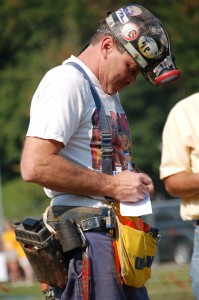 Print a Sign-In Sheet | Spanish Version Coming Soon
Print a Sign-In Sheet | Spanish Version Coming Soon
The purpose of a pre-shift inspection is to accurately assess the condition of the mine and take necessary action to correct any unsafe or hazardous conditions. This will help to reduce accidents and injuries, providing a safe workplace for the workers.
Time of Inspection
State and Federal law requires that a pre-shift examination be made within three hours preceding the beginning of any oncoming shift where miners are scheduled to work or travel.
Areas to be Inspected
KRS 352.280 requires the following areas to be examined by a properly certified person during a pre-shift inspection:
- Every working place.
- All places adjacent to live workings.
- Every roadway where persons are required to work or travel.
- All abandoned panels on the intake.
- Every set of seals on the intake.
- All roof falls near active workings on the intake and on the working sections.
Federal law 30 CFR 75.360 requires the following areas to be examined on a pre-shift inspection:
- Roadways, travel ways, and track haulageways where persons are scheduled to work or travel during the oncoming shift.
- Belt conveyors used to transport persons and entries where these conveyors are located, working sections and areas where mining equipment is being installed or removed, and where anyone is scheduled to work on the section or in the area during the oncoming shift; scope shall include working places, approaches to worked-out areas, and ventilation controls in these areas.
- Exam shall include tests of roof, face, and rib conditions on these sections and in these areas.
- Approaches to the worked-out areas along intake air courses and at the entries used to carry air into worked-out areas if the intake air passing the approaches is used to ventilate working sections where anyone is scheduled to work during the oncoming shift.
- Seals along intake air courses where air is used to ventilate working sections.
- Entries and rooms developed more than two crosscuts or driven more than 20 feet off an intake air course without permanent ventilation controls where intake air passes through or by these entries or rooms to reach a working section where anyone is scheduled to work during the oncoming shift.
- Areas where trolley wires or trolley feeder wires are to be or will remain energized during the oncoming shift.
- High spots along intake air courses where methane is likely to accumulate.
- Underground electrical installations.
- Other areas where work or travel is scheduled during oncoming shift.
Pre-Shift Examination
After making sure that the air is traveling its proper course, checking for methane and oxygen deficiency, and examining for all dangers and hazards in the assigned area, the pre-shift examiner (fire boss) shall leave at or as close as possible to the face of every place examined, the date and time of the examination initialed by the fire boss as evidence that the inspection was has performed. If there is a danger or hazard that cannot be corrected, the condition must barricaded to prevent persons from entering the dangerous area or operating the unsafe equipment. The examiner must call or deliver a report of the findings and actions taken to the surface before any persons are allowed to enter that area of the mine.
*Information from Brochure Pre-shift (Fire Boss) Inspection prepared by Harlan Office of Mine Safety and Licensing.
KEMI does not assume liability for the content of information contained herein. Safety and health remain your responsibility. This information is to be used for informational purposes only and not intended to be exhaustive or a substitute for proper training, supervision, or manufacturers’ instructions/recommendations. KEMI, by publication of this information, does not assume liability for damage or injury arising from reliance upon it. Compliance with this information is not a guarantee or warranty that you will be in conformity with any laws or regulations nor does it ensure the absolute safety of any person, place, or object, including, but not limited to, you, your occupation, employees, customers, or place of business.

